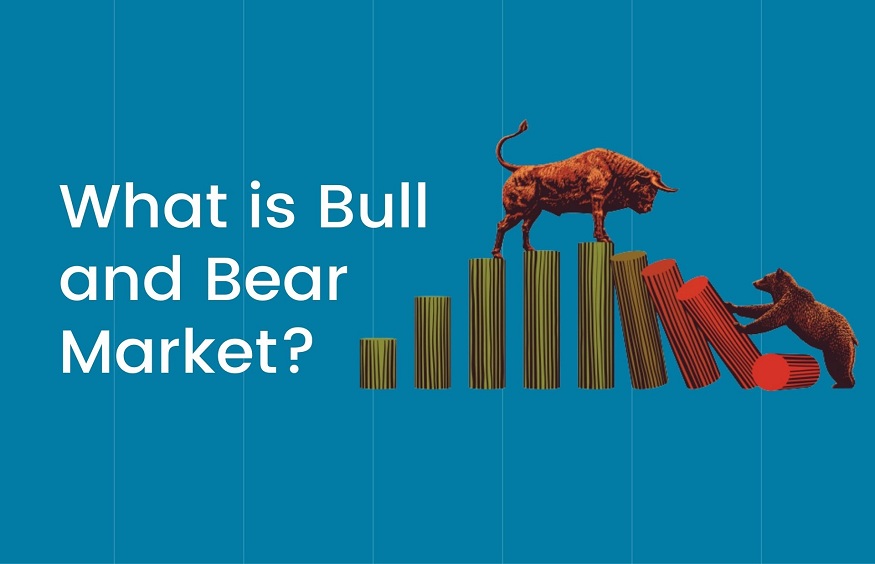In the world of trading, individuals looking to safeguard their portfolios amid hard economic times must comprehend what bearish means in the share market and its ramifications. This blog post will define “bearish,” examine bear market traits, and also how you can invest in a bearish market, but first of all, open trading account with a reliable broker is important.
Understanding the Meaning of Bear Market
A period of falling stock prices and unfavourable investor mood in the financial markets is referred to as “bearish” in the stock market. A persistent downward trend in asset values, usually indicated by a 20% or more drop from recent highs, characterises a bear market. These markets may last for a few months or even a few years. Nonetheless, the broad market attitude, which is subject to sudden swings, is frequently described as bullish and bearish. To have a better understanding, you may also read more about bull versus bear markets.
How does a Bear Market work?
Any nation’s economy and the dynamics of supply and demand are directly reflected in the stock market. If the stock market is referred to as a bear market, it might be for a variety of reasons, including high-interest rates, geopolitical conflicts, pandemics, weak economic development, recession, and shrinking GDP. Investors who are affected by these circumstances may get anxious and fearful and begin to sell their investments for liquidation.
When a lot of investors start selling their stocks, there is a greater supply of shares than there is demand for them, which drives down the price of the stock. If it goes on like this, the price will keep falling, and the bear market phenomena will get worse.
Stocks can experience a bear market for a few weeks, months, or even years. It is dependent upon what sets it off and how long it takes to resolve. For instance, if a significant sell-off occurs in the stock market as a result of a malaria outbreak, the bear market cannot recover until the disease has been contained. The bear market may last until it doesn’t, in which case prices may keep dropping.
Types of Bear Markets
Here are the types of bear markets:
Secular:
Long-term economic circumstances in the stock market, which are frequently impacted by domestic policy, are referred to as a secular bear market trend. Due to these tendencies and the high-interest rates on bonds, treasury bills, and other zero-risk products, investors are discouraged from making large investments. One of the best examples of a secular market trend was the US dot-com bubble, which lasted from 1983 to 2002.
Cyclical:
Every seven to ten years, there are economic swings that give rise to cyclical bear stocks. Following a protracted boom, markets frequently correct, with growth rates across all significant industries. Stock prices frequently experience cyclical downtrends, in which declining prices immediately rebound to a more optimistic state of affairs. A notable example of a negative market trend was the worldwide economic downturn of 2008–2009, which was brought on by the subprime mortgage crisis and the inflated housing asset bubble in America.
Market Correction v/s Bear Market
Those who are not well-versed in the stock market sometimes mistake a correction in the market for a bear market. Due to their total differences, investors are forced to lose a significant amount of money when they confuse them with one another.
A market correction is a brief occurrence in which the prices of stocks that are disproportionately expensive relative to their financial performance sharply decrease. A correction may not last more than two months, and it offers an excellent opportunity for investors to purchase a company at a discount and hold onto it until the correction ends and the price of the stock returns to its original level.
On the other hand, a bear market can last for years and is caused by political, geological, economic, or ecological factors. Investors find themselves without a favorable entry point to purchase a company in such a scenario, since the price may plummet further and stay there for years. As a result, investors run the risk of losing all of their money and experiencing prolonged liquidity. In the stock market, a bear is only advantageous to short sellers who benefit from a stock’s decrease in price. You can invest in the bear market using a free demat account with brokers like Kotak Securities.
What Should Investors Do During a Bear Market?
A stock market bear observes retreating investments from those who are not as comfortable with risk when prices are first falling. Investors who employ such an investing technique frequently suffer large losses, which further lowers their appetite for risky investments. People sell purchased securities out of concern for potential short-term losses, ignoring the significance of long-term gain in this context.
In a bear market, equities naturally correct within a few months to represent their true worth, resulting in financial gains for investors who bought the corresponding assets at a discount.
Conclusion
Bear markets, marked by stock price declines and investor pessimism, are crucial for investors seeking stability. They present both challenges and opportunities. Strategic planning and long-term vision are essential, including diversification, seizing discounted assets, and staying focused on investment goals. Kotak Neo, the best mobile trading app offers expert guidance and a secure trading platform, including a robust account, free demat account offers, and an intuitive mobile app to help navigate bearish markets and achieve long-term financial success.

